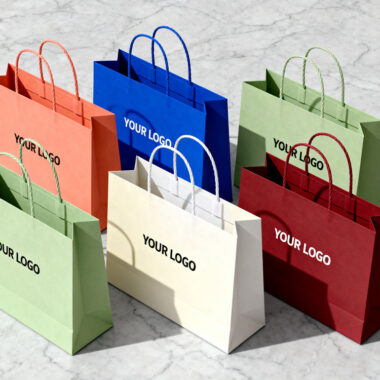🧩 1. Dieline Creation: The Foundation of Precision
Every customized paper bag begins with a dieline—a 2D technical drawing showing exact cut lines, fold areas, glue tabs, and handle positions. Professional Paper Bag Manufacturers use CAD-based dielines to ensure perfect alignment and structural integrity.
The dieline also determines printing registration and bleed zones, which are vital for color consistency during large-scale runs.
🎨 2. Graphic Design and Branding Alignment
Once dielines are confirmed, designers overlay brand artwork, logos, and Pantone color values. During this phase, a Custom Paper Bags Supplier may provide digital mockups or physical proofs.
Minimalist, high-contrast logos often perform best on kraft paper due to its natural texture. For high-end retail, foil stamping or spot UV adds a premium tactile effect.
🧾 3. Material Selection Based on Application
The material choice determines durability, price, and print quality.
-
Recycled kraft suits eco-conscious food and apparel brands.
-
White card or art paper enhances vibrant printing for gift packaging.
Suppliers usually offer sample swatches to help buyers evaluate finish, opacity, and folding behavior before confirming bulk orders.
🖨️ 4. Printing and Color Management
Printing is executed using offset or flexographic methods.
-
Offset printing provides sharp, full-color images for fashion and luxury brands.
-
Flexo printing is ideal for food packaging and large-volume orders.
Each print batch undergoes Pantone calibration to maintain brand color accuracy across thousands of units. Many factories now use water-based inks to comply with global eco regulations.
✂️ 5. Cutting, Folding, and Gluing
After printing, the sheets are die-cut using CNC or hydraulic presses based on the approved dieline. Automated folding-gluing machines assemble the bags efficiently, ensuring clean edges and uniform structures. Reinforcements are added to the base and handle areas for extra strength.
🧵 6. Handle Attachment and Reinforcement
Handles—twisted paper, ribbon, or cotton—are attached manually or semi-automatically.
A Custom Paper Bags Supplier ensures that handle types match the intended usage. For heavy retail items, rope or flat handles with reinforced tops are preferred, while lightweight die-cut handles are better for takeaways.
📦 7. Quality Inspection and Delivery
Before shipment, manufacturers perform AQL sampling for printing alignment, glue adhesion, and handle strength. Bags are then packed flat into cartons to minimize volume.
Custom barcoding, palletization, and documentation follow, allowing buyers to track their shipment from factory to warehouse seamlessly.
🌍 8. Why the Workflow Matters
Understanding each stage empowers buyers to negotiate better and avoid rework. When retailers collaborate closely with manufacturers, they can align dieline design, printing setup, and logistics — saving both time and cost while ensuring brand consistency across all stores.














